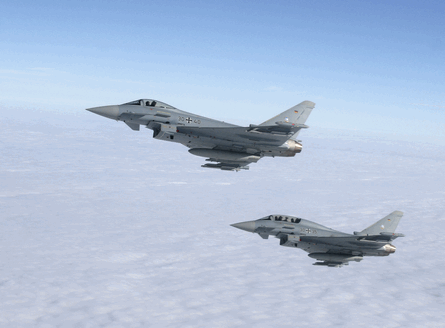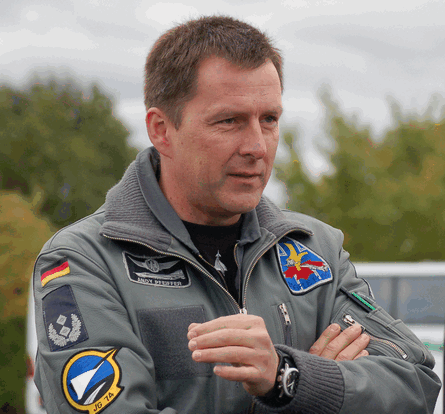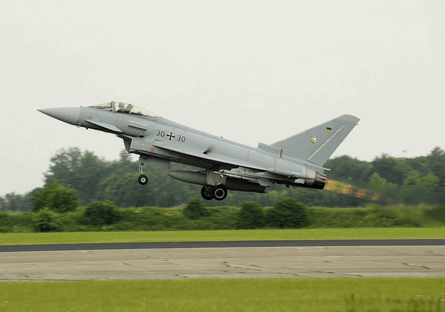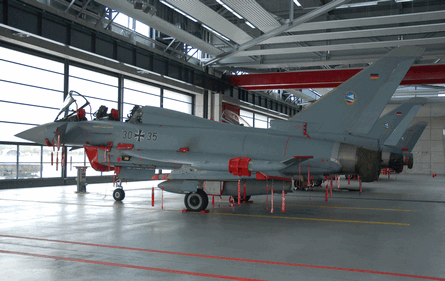After four months of flying air policing missions, Germany's air force is happy with the operational performance of its new Eurofighter interceptors but its ability to meet related training commitments is being hampered by a serious shortage of aircraft.
Located at Neuburg/Donau air base near Munich, Fighter Wing 74 (FW74) has encountered a steep learning curve since July 2006, when it became the first and so far only frontline air force unit to field the Eurofighter. Now operating with a combination of its 741 and 742 squadrons, FW74 has overcome early reliability issues that had affected its performance, and on 3 June began providing quick reaction alert (QRA) cover with the type over southern Germany.
 |
|---|
© Stefan Gygas/Luftwaffe |
The recent milestone was achieved despite the Neuburg wing being significantly below planned operating strength, with just 10 aircraft and 16 trained pilots now at its disposal. The problem stems largely from Berlin's support for the four-nation Eurofighter consortium's sale of 15 Typhoons to Austria, which after much negotiation resulted in 11 of the German air force's planned Tranche 1 production aircraft being diverted to its neighbour. Crucially, this total includes seven single-seat fighters originally set for delivery to Neuburg.
EADS Deutschland has already completed the delivery of the air force's 39 Tranche 1 aircraft, including one instrumented production example dedicated to supporting development and flight-test activities. But the need for the service to return 14 of these to pass through a Block 5 upgrade has exacerbated the effects of the Austrian transfer.
"Our main task today is air policing," says FW74 commander Lt Col Andreas Pfeiffer, who adds that the need to provide sustained QRA services requires the unit's entire 10-aircraft inventory. Two armed aircraft plus two spares are held at 15min readiness at Neuburg, with the air force expecting each of these to fly three times a day.
 |
|---|
© Craig Hoyle/Flight International |
A former McDonnell Douglas F-4 Phantom pilot with additional experience in operating the service's ex-East German air force RSK MiG-29 interceptors, Pfeiffer says FW74 is achieving an availability rate of "better than 50%" for all its operations, but is fully meeting its air policing commitments.
F-4 "FLY OUT"
A "fly-out" event for Neuburg-based F-4Fs took place less than two weeks after the Eurofighter fleet assumed QRA responsibility, and Saab Gripen C/D fighters from the Czech Republic's Caslav air base are available to provide back-up support or emergency cover if required. Air policing for northern Germany continues to be provided by FW71-operated F-4s flown from Wittmund air base.
Due to the small number of aircraft so far delivered and the need to have eight pilots allocated to air policing tasks each week, FW74's squadrons are able to conduct only limited further training. Requirements include taking pilots from the FW73 Operational Conversion Unit at Laage in north Germany and advancing them to limited combat-ready status, but Pfeiffer says: "We're barely able to cover all the administration jobs."
This situation will partially improve before year-end, with the Neuburg fleet to be boosted by the arrival of FW74's first two Tranche 2 aircraft in November and December. Training is expected to ramp up significantly towards the end of 2009, by which time the wing should have received 18-20 Eurofighters. Some 23 of Germany's Tranche 2 aircraft are now in final assembly, says EADS.
 |
|---|
© Geoffrey Lee/Plane Focus |
The Eurofighter partners in mid-August approved type acceptance of the Tranche 2, Block 8 aircraft, clearing the way for deliveries to begin from four final assembly lines around Europe. Weapons and radar testing work is now under way.
"It will take us two or three years to get to full strength," says Pfeiffer, which will mean the availability of 35 aircraft and 53 fully trained pilots. Accordingly, the air force is likely in 2009 to repeat its current detachment of F-4s to provide QRA cover for Baltic states Estonia, Latvia and Lithuania, and has yet to decide whether it will commit aircraft to similar future activities from Iceland.
German Eurofighters assigned for air policing duties are armed with an internal 27mm Mauser cannon and Diehl BGT Defence IRIS-T short-range air-to-air missiles, and carry an external fuel tank for increased time on station.
"IRIS-T is very successful in flying operations, it gives us the capability we need," says Col Joachim Vergin, chief of the German air force command's operations branch. In the longer term, he says, the nation's defence ministry will decide on whether to acquire MBDA's beyond-visual-range Meteor missile after assessing the results of future tests involving the developmental system. But he notes: "We need a long-range weapon, there's no doubt about that." Should Berlin decide against investing in the UK-led Meteor weapon, additional candidates would include Raytheon's AIM-120 AMRAAM.
FW74's aircraft are increasingly using their Link 16 datalinks during operations, but Pfeiffer says their lack of a night vision goggle capability is a "challenging" issue. However, this will be resolved once a new helmet design has completed development activities for the Eurofighter, he adds. Another current shortcoming stems from Germany's decision not to invest in the Typhoon's Pirate forward-looking infrared sensor selected by the programme's other core nations Italy, Spain and the UK. "A FLIR is something we're interested in for the future," confirms Vergin.
Today's operations are also complicated by the need to perform "buddy-buddy" air-to-air refuelling using Panavia Tornado strike aircraft. However, work is starting in a bid to clear the air force's Airbus A310 multirole tanker transports to support the Eurofighter. "We hope for widebody AAR certification soon," says Pfeiffer.
FW74 in August passed the 2,000 flight hour mark with its Eurofighters, and operations are running at around 230h above initial planning assumptions for this year. "It is a much more stable platform than we expected," says Pfeiffer. Germany's entire fleet passed a combined 7,000 flight hours earlier this year, while Europe's five operating air forces in August passed a combined total of more than 44,500h.
The German air force says its Tranche 1, Block 5 aircraft are a clear advance over the programme's earlier Block 1 and 2 standards, most notably in areas such as avionics equipment. "The reliability has improved significantly within the last year, and we are getting a really good upslope on the flying hours at Neuburg and Laage," says Vergin. "We have no problems in using the aircraft," he adds. Maj Marc Grüne, 742 Sqn commanding officer, concurs. "Every day the skills of the pilots and technicians are getting better," he says.
FLIGHT HOURS
Germany's defence ministry expects each of its Eurofighter pilots to log around 150 flight hours a year, plus a further 30-40h to be amassed using simulators and other synthetic training devices.
With a peacetime strength of around 1,500 personnel, Neuburg is one of the smallest fighter bases sustained by a NATO nation. Destroyed by allied bombing in 1945 after playing host to operational testing of the Messerschmitt Me-262 jet fighter, the base returned to German control in 1961, subsequently hosting fighter operations with the North American F-86K Sabre, Lockheed F-104 Starfighter and the F-4.
The base is the subject of an ongoing modernisation effort worth around €100 million ($135 million), with two-thirds of this investment linked to operations of the Eurofighter. Current work at the site includes transforming aged QRA shelters to house the new aircraft.
Despite its current operational constraints, FW74 plans to participate in its first major international deployments next year, including a planned campaign of weapons testing at the Decimomannu range in Sardinia. Elements from the unit are also expected to be deployed to the UK next year to participate in an exercise alongside Tornado GR4s at the Royal Air Force's Lossiemouth air base in Scotland.
"What we can do we will do," says Pfeiffer. "We are only just at the beginning, but it is an awesome step forward."
GERMANY EMPHASISES ITS COMMITMENT
Germany's commitment to the four-nation Eurofighter programme accounts for 180 of the 620 aircraft included in an umbrella contract spread across three production tranches.
With 38 aircraft now assigned to units at its Laage and Neuburg air bases, the air force already has well-established plans to expand its fleet rapidly, and to equip additional fighter and strike wings with the new type from next year. Ahead of the move, the first German students set to move on to the Eurofighter directly from the Euro-NATO Joint Jet Pilot Training system in the USA began training in July.
 |
|---|
© Craig Hoyle/Flight International |
The air force's standard procedure for adding new Eurofighter units is to wait until an existing wing has received 24 aircraft. With deliveries set to reach between 49 and 53 Eurofighters by late next year, the service aims to establish its first fighter bomber wing with the new type at Nörvenich. FBW31 is expected to receive its first aircraft in December 2009, says Col Joachim Vergin, chief of the German air force command's operations branch.
EADS is expected to have handed over a third of Germany's Eurofighters by late 2010, and plans call for the air force to stand up FW71 at Wittmund in 2011 and FBW33 at Büchel in 2013.
Although its first fighter bomber wing will be formed in 2009, the air force's use of the Eurofighter as an air-to-ground strike asset will take several more years to come to fruition.
Capabilities such as a fully integrated targeting pod and a laser-guided bomb will be introduced around 2011-12 as part of the programme's Phase 1 enhancement deal. A Phase 2 proposal tabled by Eurofighter to the partner nations also includes the Taurus cruise missile, built by Swedish-German joint venture Taurus Systems and set for use by the air force.
Germany has yet to decide on additional future air-to-surface weapons for the Eurofighter, although EADS Defence and Security senior vice-president combat air systems Berndt Wünsche says the air force has shown some interest in the nationally developed Hope and Hosbo systems, which could be used to strike moving targets. "The Luftwaffe has interest, and we are preparing to be able to integrate those weapons," he says. Boeing's laser- and GPS-guided GBU-54 Joint Direct Attack Munition system is another potential candidate for the service.
Germany's current logistics model is for a two-tier system with periodic maintenance performed on the air bases and scheduled work to occur at EADS's Manching site near Munich, which already houses a joint EADS and German defence ministry system support centre for the type. The air force has no plans to establish performance-based logistics arrangements for the aircraft, says EADS.
Negotiations are under way for the four-nation programme's Tranche 3 order for 236 aircraft, but Germany says it intends to honour fully its planned purchase of the type. The air force also expects to retain 85 Panavia Tornados in the interdictor strike, reconnaissance and electronic combat/reconnaissance roles until beyond 2020, although EADS believes the type's service life could extend to between 2025 and 2030.
SIMULATORS PLAY KEY ROLE IN GERMAN MODEL
The use of simulation is a key element of Germany's operational model for the Eurofighter, with its Neuburg base hosting its own Aircrew Synthetic Training Aids (ASTA) facility.
Now being completed, this comprises three synthetic training devices - a full mission simulator with an 8m (26ft) dome, a cockpit trainer and a flying training device. The equipment is in the final stages of installation, having recently been moved to the site after initial use at EADS's Manching site near Munich.
To be capable of supporting pilot currency, pre-flight training and mission rehearsal including electronic warfare tasks, the ASTA system at Neuburg is staffed by 15 full-time personnel, including nine technicians.
Employing real software from the Eurofighter, the synthetic trainers can create up to 400 computer-generated forces, including up to 200 air entities, plus 150 ground targets and 50 maritime threats.
"We will be able to link the devices from early 2009," says Neuburg ASTA facility manager Franz , of EADS. "The goal is to link here, and then with other German air force sites." Funding approvals have yet to be put in place for the latter, but if granted it would enable pilots at the air force's eventual four frontline Eurofighter bases to conduct networked training using eight training devices.
Source: Flight International























